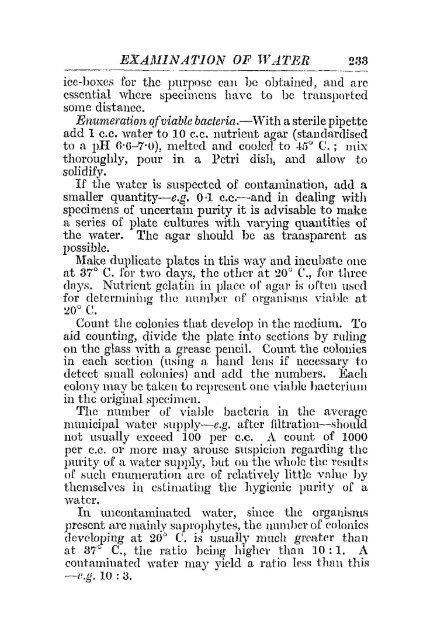AGf~ICULTURAL RESEARCH, PUSA.
AGf~ICULTURAL RESEARCH, PUSA.
AGf~ICULTURAL RESEARCH, PUSA.
Create successful ePaper yourself
Turn your PDF publications into a flip-book with our unique Google optimized e-Paper software.
EXAlIl1NA'l']ON OF' TVA'l'BR 233<br />
_----------- -'---- _--------ice-boxes<br />
for thc purpose can be obtained, and arc<br />
esscntial where specimens have to be transported<br />
some distancc.<br />
Enurneratlan afviable bactcl'ia.-With a sterile pipette<br />
add 1 c.c. water to 10 c.c. nutrient agar (standardised<br />
to a pH ()'u-7'O), melted and coolerl to .15 0 C.; mix<br />
thoroughly, pour in a Petri dish, and allow to<br />
solidify.<br />
If the wuter is suspectcd of contamination, add a<br />
smaller quantity-e.g. 0·1 c.c.-and in dealing with<br />
specimens of uncertain purity it is advisable to make<br />
a series of plate cultures with varying quantities of<br />
the water. The agar should be as transparent as<br />
possible.<br />
Make duplicate plates in this way and incubate one<br />
at 37° C. for two days, the other at 20° C., for three<br />
days. Nutrient gelatin in place of agar is often w.;ed<br />
for detel'Illinillg the muul)l:r of' OJ'ganisllls viable at<br />
:,w0 C.<br />
Count the colonies that develop in the medium. To<br />
aid counting, divide the plate into sections by ruling<br />
Oll the glass with a grease pencil. Count the colonies<br />
in each section (using a hand lens if' necessary to<br />
detect small colonies) and add the numbers. Each<br />
colony may be taken to represent one \'iable hacterium<br />
in the original specimen.<br />
The number of' viable bactcria in the average<br />
municipal water supply-e.g. aftcr filtration-should<br />
not usually exceed 100 per c.c. A count of 1000<br />
per c.c. or more may arousc suspicion regarding thc<br />
purity of' a water supply, hut Oll the whole the results<br />
of such enumeratioll arc of relatively little valu£' by<br />
thcmselves in cstinlUtillg the hygienic purity of a<br />
watcr.<br />
In ullcontaminated water, since the organisms<br />
prcscnt are mainly saprophytes, the llUlnher of eolonics<br />
developing at 20'; C. is usually much greater than<br />
at 37° C., the ratio heing highcr than 10: 1. A<br />
contaminated ,vater may yield a ratio less than this<br />
-c.g. 10: 3.

















